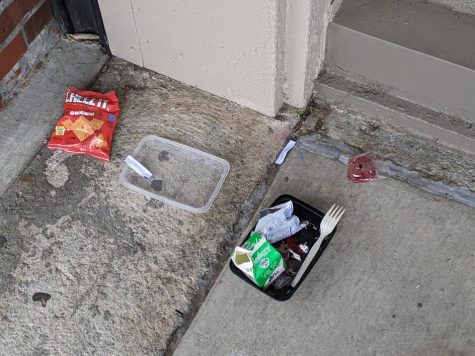Not throwing away our trash
Explaining the consequences of littering at MVHS
April 27, 2022

When facilities manager Eddy Medal first began working at MVHS in 2021, he was shocked at the amount of waste that gets left behind on campus — the site resembled the aftermath of a food fight he thought only played out in cliché high school movies. Medal noticed the milk containers, fruits and food trays scattered around campus, describing how excess litter makes it difficult for him and his team to maintain a safe and clean environment.
Medal emphasizes that food litter promotes rodents to come onto campus, citing the recent rat infestation on campus. For him and his team, it’s also difficult to keep up with the constant milk spills and trash left lying around. He details how daytime custodians spend most of the day picking up litter, taking time away from tending to other aspects of the school — for example, a small grove of trees recently died on campus due to the lack of water, a problem that Medal can’t fix as efficiently without his team working on it with him.
“We need to fix it,” Medal said. “We need to get to that, but my guys are spending a better part of the day picking up trash and litter on the ground and bagging trash. It’s [almost] a full time job here [and] it’s a big process. We obviously don’t want to pick up trash all day long, but that’s a better part of our day here, as janitors or custodians and gardeners, that’s what they do during the day shift.”
The littering problem is noticeable around campus, including by Biology teacher Lora Lerner, as she points out how there’s usually a pile of litter next to her classroom in the back of the B-Building. She mentions how walking by it everyday is not only “unpleasant” and aesthetically displeasing, but also that the behavior of students shifts in tandem with the environment they’re exposed to.
“There’s tons of studies showing that people really respond to how their environment is,” Lerner said. “When there is litter or graffiti around, people may not behave as well [since] there’s kind of this feeling of, ‘Oh, it doesn’t matter that much.’ Whereas when things look nice, people actually behave a little bit better. And I think there’s something to that. If it just looks like we just kind of trash things around here, [it’ll] affect the way people think about the school themselves, their behavior, whereas if it looks really nice, I think people are much more likely to be better themselves, and not [just] to litter but also to think, ‘Hey, this is a nice place we should be heading.'”
Medal conveys that although the daytime custodians are doing “the best they can,” when people litter in hidden places such as in bushes, the trash can remain there for long periods of time. The litter that doesn’t get picked up contributes to a broader environmental problem which Lerner emphasizes. She describes how the most problematic component is plastic due to its slow decomposition rate, which causes it to harm the environment since it remains for so long and can leach chemicals into the soil and be consumed by organisms.
To reduce the littering problem, Lerner suggests that admin could provide more accessible trash cans and recycling bins or create litter containers to put in areas students don’t access as often. However, she believes that the responsibility mostly falls on the students, and that they need to enforce a culture that promotes picking up after themselves.
“It has to really be something people are aware of, so that they don’t just let it go,” Lerner said. “Because I think that when one person lets it go, the next person [does too] and it just gets worse. So I think if you want to be in a school that looks really nice — [and] we’re fortunate to have a school that looks nice — we all have to kind of take that extra two seconds to pick up our stuff and take it with us.”
Junior Daniel Yang recounts how he has had to pick up the litter his friends leave during lunches and brunches. He echoes Lerner’s sentiment that students have to play a bigger role in shifting the culture. He explains that most high schoolers don’t take environmental issues that seriously and that awareness is important in combating this issue.
“Teenagers just don’t really care about littering and they [don’t] think it’s a big problem,” Yang said. “They kind of treat it as a joke and they don’t think it’s a big deal, [maybe because] they just don’t really care about [the] school or the community.”
Medal has tried increasing the number of trash cans placed around campus, but despite his efforts, he still doesn’t see enough progress on the ground. He describes littering as a “bad habit that needs to be broken” and how individuals need to put in their “honest effort to try to get the trash back into the trash containers.”
“Do your best to think that this is your home,” Medal said. “This is where you have to be a better part of your day. And a lot of these people that leave their trash behind, they’ll leave it in the same area that they sit in, and then the next day, they sit in the same area. And they’re dealing with the same filth that’s there. We clean up the mess, but if they spilled something, we might not have washed it down yet, so now they got something spilled where they’re sitting. It’s [simple], take care of your home.”



























